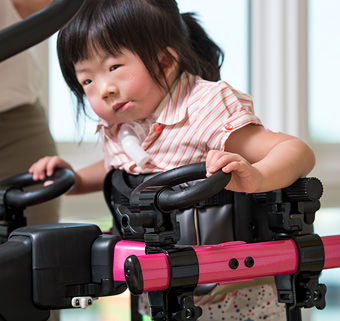Evidence Update: Children with CP and Home-based Treadmill Programs
| September 2017 Motor learning suggests that practice, repetition and task specificity are instrumental to task improvement. Sometimes extending the practice of therapeutic activities beyond the clinical environment and into the home is a great way to apply these principles and reinforce the gains made in the clinic.
Motor learning suggests that practice, repetition and task specificity are instrumental to task improvement. Sometimes extending the practice of therapeutic activities beyond the clinical environment and into the home is a great way to apply these principles and reinforce the gains made in the clinic.
Knowing this, I was interested to read a recent study looking at children with cerebral palsy and the value—and feasibility—of participating in a home-based body-weight supported treadmill program. Research has shown us the benefits of body weight supported treadmill training (BWSTT) for such children. It is, first of all, a safe way to gait train with increased repetition. Then there are the intervention-specific increases in functional mobility, endurance and gait speed.
Potential Benefits of Home-Based Programs
Preliminary studies showed that home-based treadmill intervention has the potential to improve gait in children with cerebral palsy while eliminating the common barriers of scheduling and lack of access to transportation.  The authors implemented a 12-week pilot study to look at functional improvements from a program of home-based treadmill training for ten children with cerebral palsy (6 - 16 years old and GMFCS levels II and III). The families of the children were provided with a Wingman MultiSport Harness and ceiling mount kit installed above their treadmill.
The authors implemented a 12-week pilot study to look at functional improvements from a program of home-based treadmill training for ten children with cerebral palsy (6 - 16 years old and GMFCS levels II and III). The families of the children were provided with a Wingman MultiSport Harness and ceiling mount kit installed above their treadmill.
After an initial therapist home visit, the parents and caregivers then conducted the BWSTT sessions 3-4 times per week (maintaining weekly phone calls with the researchers for protocol instruction).
Is Home-Based Treadmill Training Feasible?
At the end of the program significant improvements were seen in walking capacity and functional mobility pre- and post-testing. These findings are similar to other BWSTT program findings in non-home-based settings. Adherence to the program was fair and the researchers concluded that a home-based treadmill program for children with cerebral palsy is indeed feasible.
The study authors recommend additional research to examine how this type of intervention relates to secondary impairments, participation and the maintenance of functional capacity in the long run.
Reference:
Visser A, Westman M, Otieno S, Kenyon L. A home-based body weight-supported treadmill program for children with cerebral palsy: a pilot study. Pediatr Phys Ther. 2017;29:223-29.





